WE RIDE PHIL NICOLETTI’S LONELY JGR SUZUKI RM-Z250
Click on images to enlarge
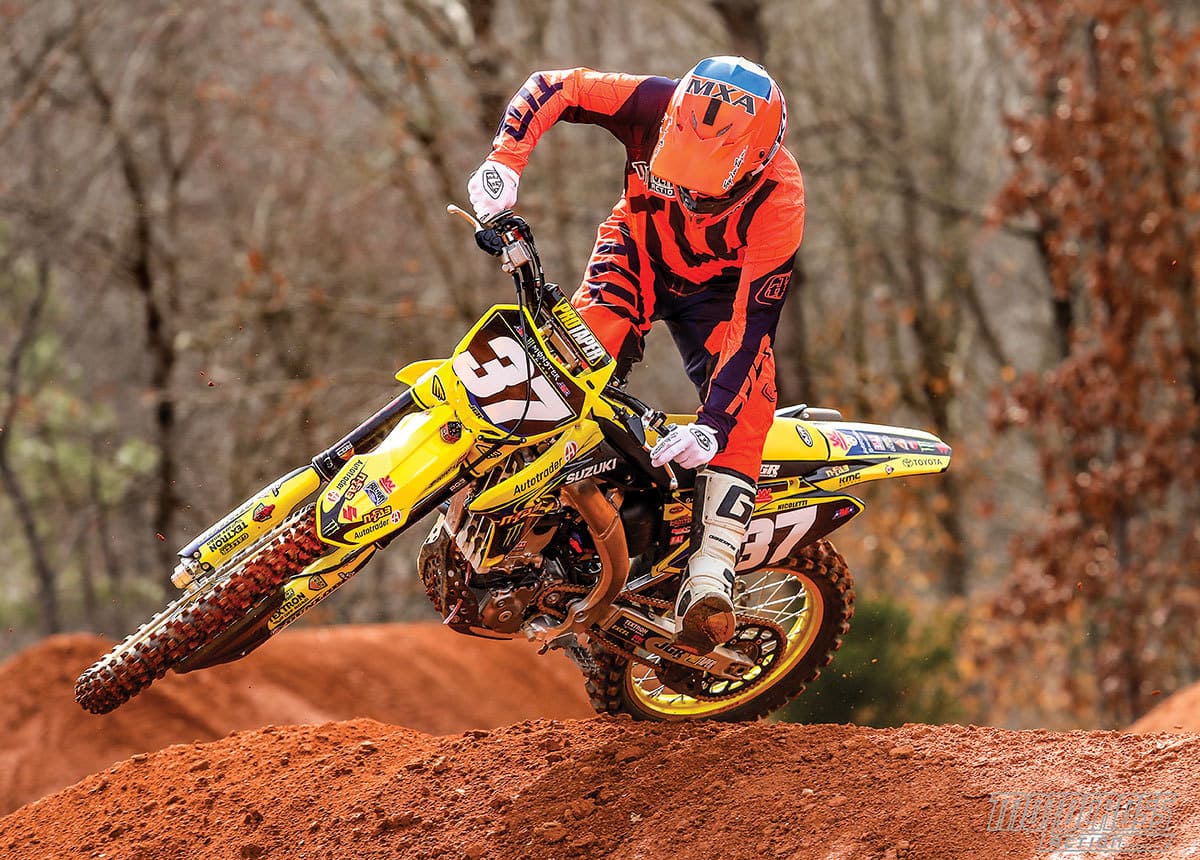
Coming into the 2017 season was a hectic time for the JGRMX team. To race or not to race Suzukis was the burning question. Yamaha and JGR had a falling out during the off-season, and since JGR’s Yamaha contract had expired, JGR was free to find a new bike supplier. Suzuki was the logical choice, but with RCH already signing on the dotted line to be Suzuki’s factory supported team, Suzuki’s budget was maxed out. Yet, Suzuki wanted to find a way to get JGR on board. In the end, a one-year contract was drafted for the 2017 season, but the entire JGRMX team was investing for the long haul in yellow.
After the agreement between Suzuki and JGR was signed to back the 450 effort, Suzuki Japan asked JGR if they had any interest in running the 250 program as well. JGR said they had room in their semi for one 250 rider on each coast. Suzuki agreed to the terms. The JGR 250 East/West would be the first full-blown, factory-backed Suzuki 250 effort since 2009 (with Ryan Dungey and Cole Seely). Suzuki Japan, Yoshimura and RG3 Suspension would back the 250 effort 100 percent. That meant JGRMX was able to take a step back from having to develop the engines and suspension. JGR signed Phil Nicoletti and Matt Biceglia for the 250 class. Nicoletti made it through the first six 250 West rounds before breaking his ankle, while Bisclegia never made it to the starting line because of a series of injuries.
Phil Nicoletti has been with the JGRMX team for a very long time, and in recent years has contributed a lot as a test rider. Phil is uniquely capable of communicating what he is feeling to the technicians. Good test riders are surprisingly hard to find, especially at the professional level. Phil spent a lot of his time making things easier for Justin Barcia and Weston Peick. Phil also functioned as JGR’s in-house fill-in rider for the 450 class.
“AFTER PHIL DISLOCATED HIS ANKLE AT THE DALLAS SUPERCROSS, MXA CONNECTED WITH JEREMY ALBRECHT AND VOLUNTEERED TO MAKE SURE THAT NOTHING GOT RUSTY ON PHIL’S FULL-FACTORY RM-Z250 WHILE HE HEALED UP.”
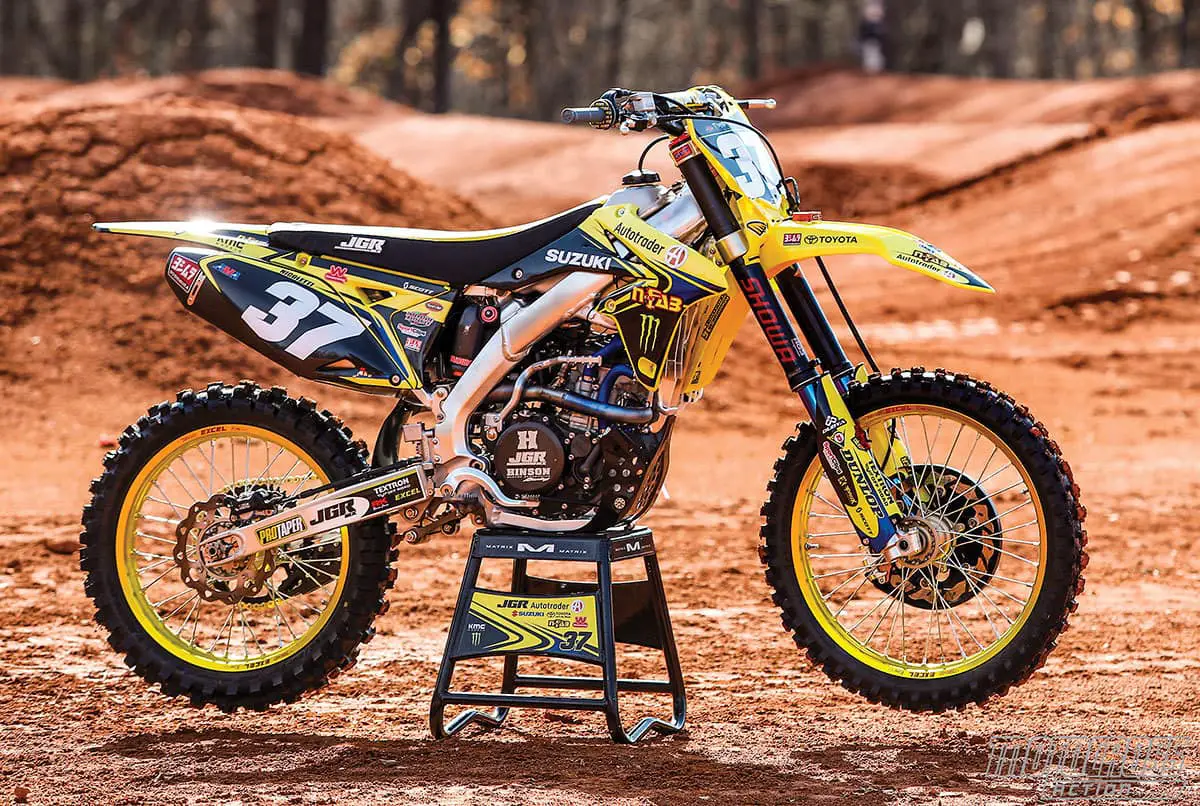
For 2017 Phil was signed to race and help develop the RM-Z250 for Supercross and to race the RM-Z450 for the AMA outdoors. After Phil broke his heel and dislocated his ankle during press day at the Dallas Supercross, the West Coast Supercross went on hiatus and Phil’s bike became no more useful than a paperweight. MXA connected with Jeremy Albrecht, team manager of JGRMX, and volunteered to head to North Carolina to help make sure that nothing got rusty on Phil’s full-factory RM-Z250 while he healed up. His bike was lonely and we volunteered to keep it company.
In stock trim the 2017 Suzuki RM-Z250 is the heaviest in its class at 226 pounds. It is also the lowest on the totem pole when it comes to horsepower. Phil’s factory bike is littered with titanium and carbon fiber to shed as much weight as possible. A good 95 percent of all the hardware on his JGR bike is titanium. The RM-Z250 easily meets the AMA’s minimum weight requirement.
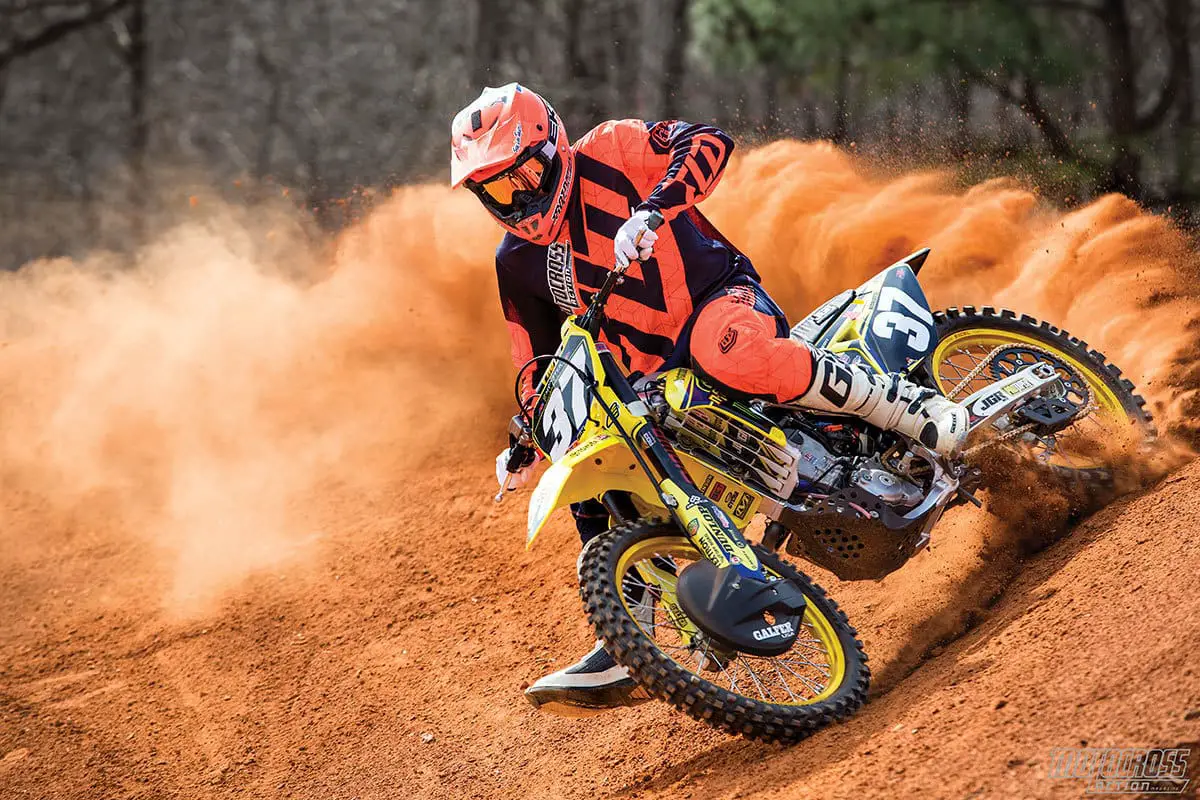
The 250-built engine JGRMX first got from Suzuki was mainly developed in Europe for the Grand Prix series. Since Supercross is so different from outdoors, the engine, although fast, didn’t have the bottom and mid needed for tight Supercross tracks. Phil spent most of his preseason in California getting the bike dialed for the 250 West Supercross series. Phil told us that coming into the season he was really happy with what they achieved with the total package. The engine had the bottom and midrange he wanted, although they were still trying to find a way to get more over-rev so the bike could pull the same gear another 10 feet or so.
“WITH A PLETHORA OF FACTORY PARTS COVERING THE BIKE, WE WERE MOSTLY INTRIGUED BY TWO THINGS. THE FIRST ONE WAS A WIRE THAT WENT INTO THE AIRBOX.”
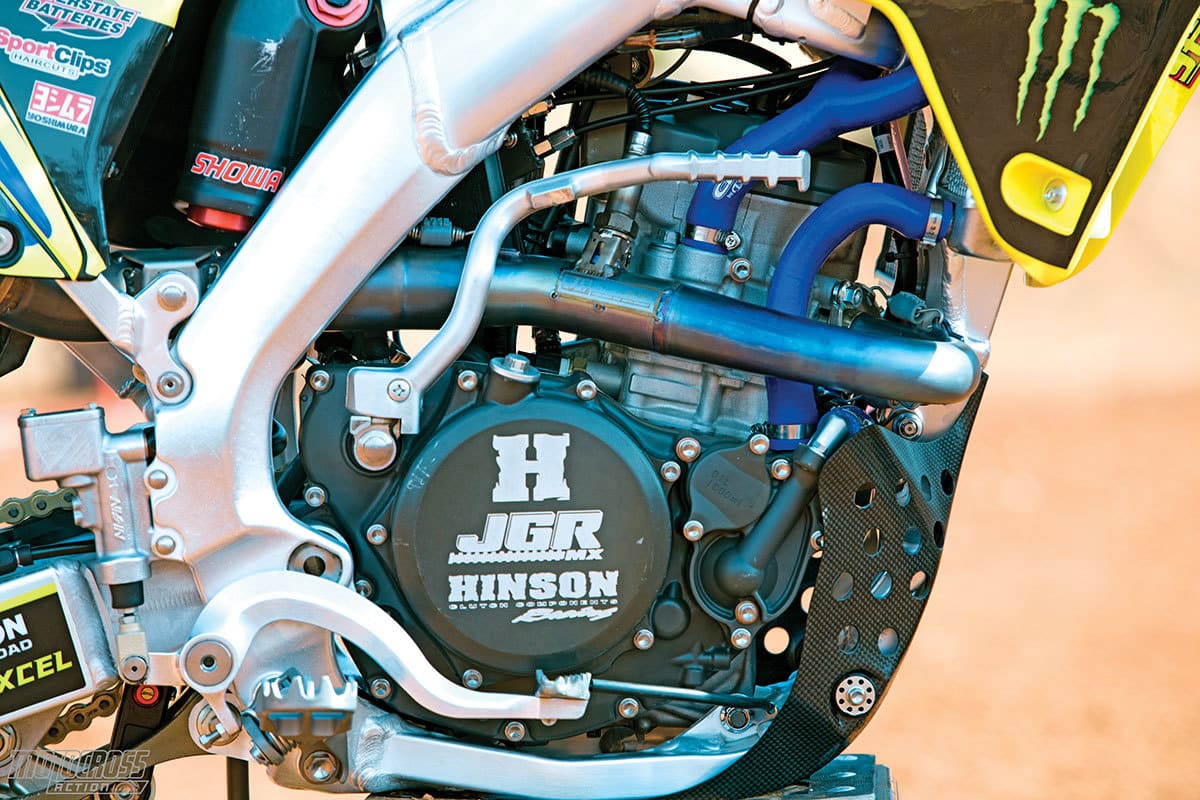
“This is the best chassis I have ever raced with,” commented Phil. The out-of-the-box RM-Z250 chassis is great for Supercross due to Suzuki’s turn-at-all-costs philosophy. Phil, however, felt that the ergonomics of the bike were off for his style of riding. It felt low in the front and high in the back. To make him comfortable, he ran 33mm-high bar risers, as well as a 5mm spacer that went under them. He also moved the bar mounts 1mm forward. He felt like the rear of the bike was kicking him in the butt at times, so they cut and lowered the subframe and shaved the rear of the seat down. Phil also changed to 20mm outset triple clamps to get more traction on the front wheel.
With a plethora of factory parts covering the bike, we were mostly intrigued by two things. The first one was a wire that went into the airbox. We asked Phil’s mechanic, Isaiah Murphy, what the wire led to. We were surprised by his answer. The wire leads to a battery in the airbox. This battery powers the GET data system and its sensors. It turns out that the data system needed more juice than the magneto could generate. It is a small 4-cell battery like the ones used on RC cars. Next, we noticed that Phil’s Suzuki RM-Z250 was running something that we find on lots of Honda, Yamaha, Suzuki and Kawasaki Pro bikes—a KTM throttle body. Isaiah smiled and moved on to something else when we pointed it out. But, it is no secret that the location of the KTM’s throttle-body injector nozzle, which is the opposite of the nozzles on Japanese models, mists the fuel more efficiently. We see this throttle body on a large number of factory bikes.
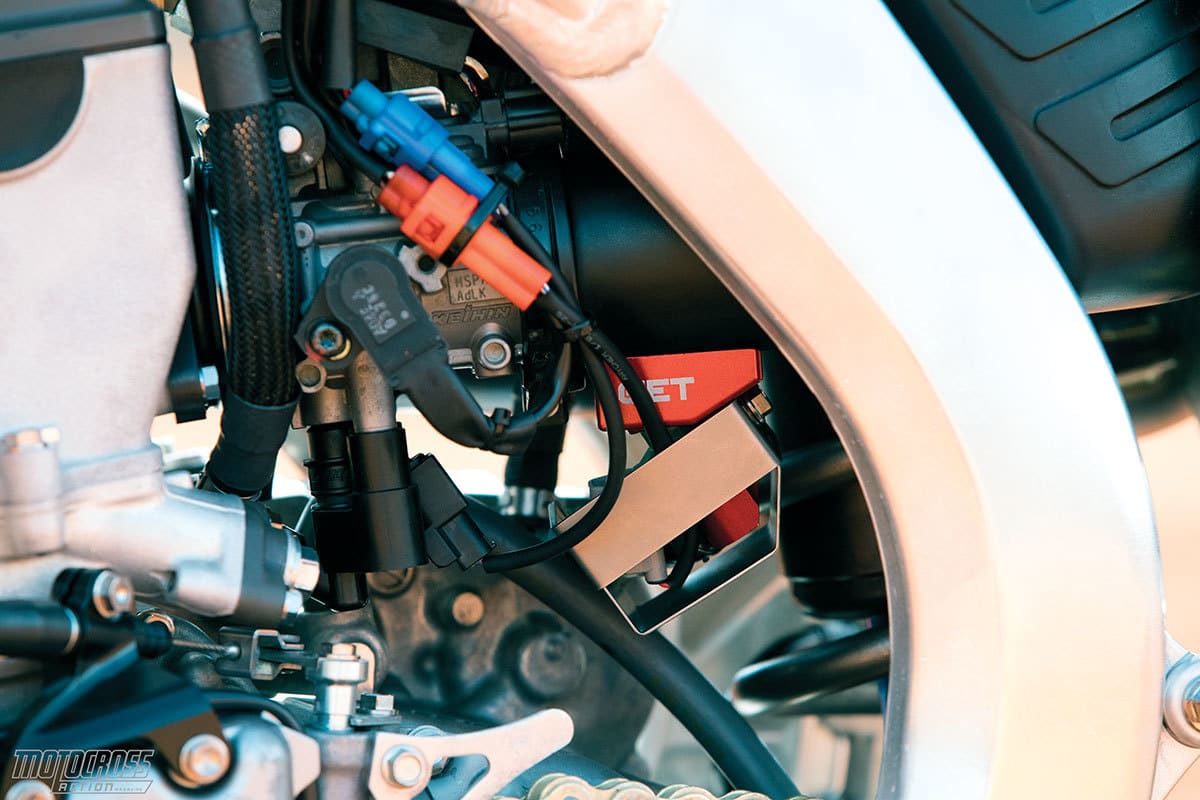
The setup of Phil’s bike is pretty basic. The levers are set in a neutral position, with the front brake lever a little lower than the clutch (even though Phil feels that they are level with each other). Phil runs his rear brake pedal on the low side for a Pro rider. Why? He says he has a tendency to ride the rear brake pedal if it’s high. Conversely, he runs the shifter one notch higher than normal but has a fatter shifter tip for an improved feel.
We spent all of our time on Phil’s JGRMX Suzuki RM-Z250 on JGRMX’s Supercross test track. The first thing we noticed was the change in ergonomics. The small changes Phil made really allowed our test riders to feel at home, especially our bigger riders, as the taller front and lower rear made the cockpit feel larger. The engine was potent out of the corners and didn’t require much in the way of clutch help. The power changes were interesting, as the RM-Z250 delivered a 450 style of power. We could almost lug the bike around the corners, although we felt a little hampered by the lack of over-rev. The short top end meant that riders couldn’t be lazy and just wind it out on top; they had to short-shift. On a side note: Kyle Peters, who was the replacement rider for Matt Bisceglia before he was replaced by Kyle Cunningham, was at the JGR test track when we were there, and he had a different engine that had a longer over-rev.
“THE POWER CHANGES WERE INTERESTING, AS THE RM-Z250 DELIVERED A 450 STYLE OF POWER. WE COULD ALMOST LUG THE BIKE AROUND CORNERS.”
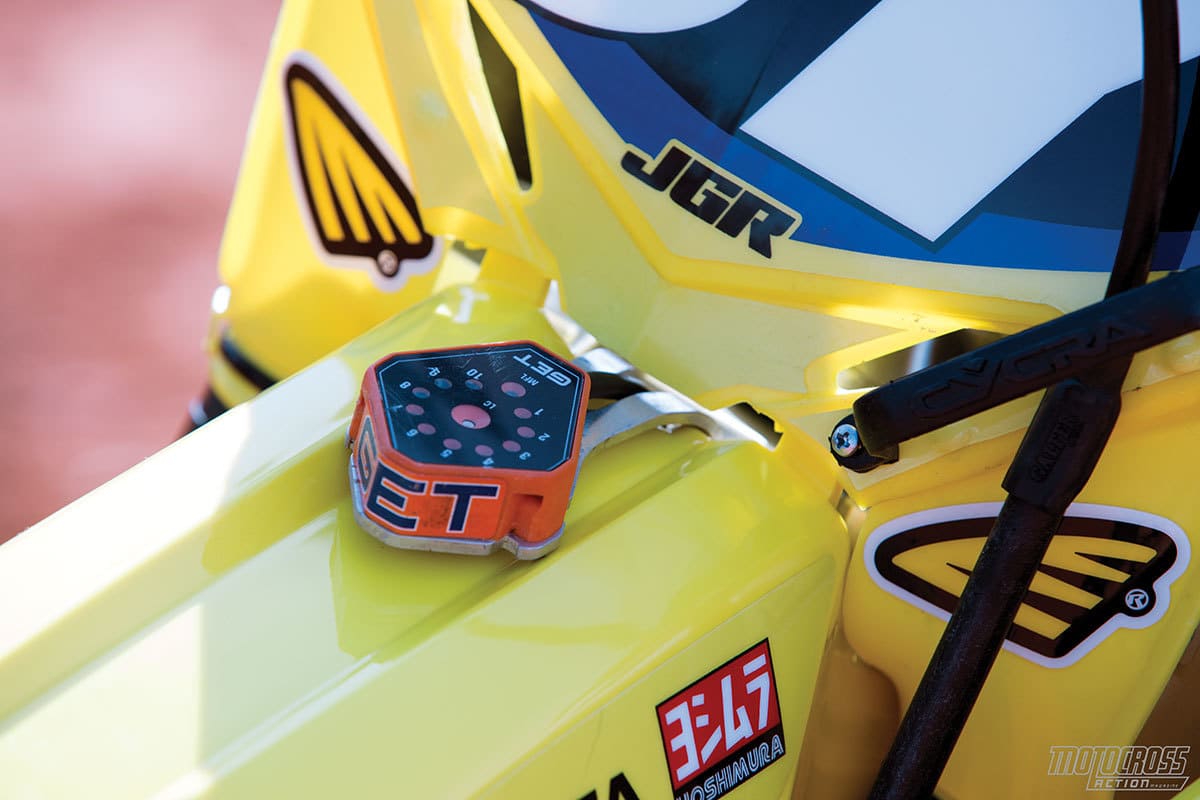
The JGR RM-Z250 felt light and nimble on the track, which is something that even the heavy stocker is capable of. We struggled a little with oversteer that knifed the front end on occasion due to the 20mm offset (stock is 22mm); however, the faster we rode, the better the front end tracked. Of course, the suspension was on the stiff side. This is normal with the Supercross bikes of Pro riders, because they ride Supercross every day of the week and go a little stiffer all the time. The shock had a classic Supercross dead-feeling that gave our riders confidence that the rear end wasn’t going to come up unexpectedly. The forks were stiff but had some plushness at the top to absorb some of the small chop that Supercross tracks develop. The front brake was amazingly strong but had a graduated feel that made it easy to modulate.
Make no mistake about it; JGR has a potent Suzuki RM-Z250—and they managed to build it in an amazingly short period of time after their last-minute departure from the Yamaha fold. It was surprising how fully the bike was developed, especially given that Suzuki had very little RM-Z250 race data from the last seven years to share with JGR. More significant is that the JGR effort might breathe life into Suzuki’s moribund RM-Z250 production program. A motivated Suzuki has been a powerhouse in the past, so we are excited to see what the collaborative efforts of Suzuki and JGRMX bring in the years to come.



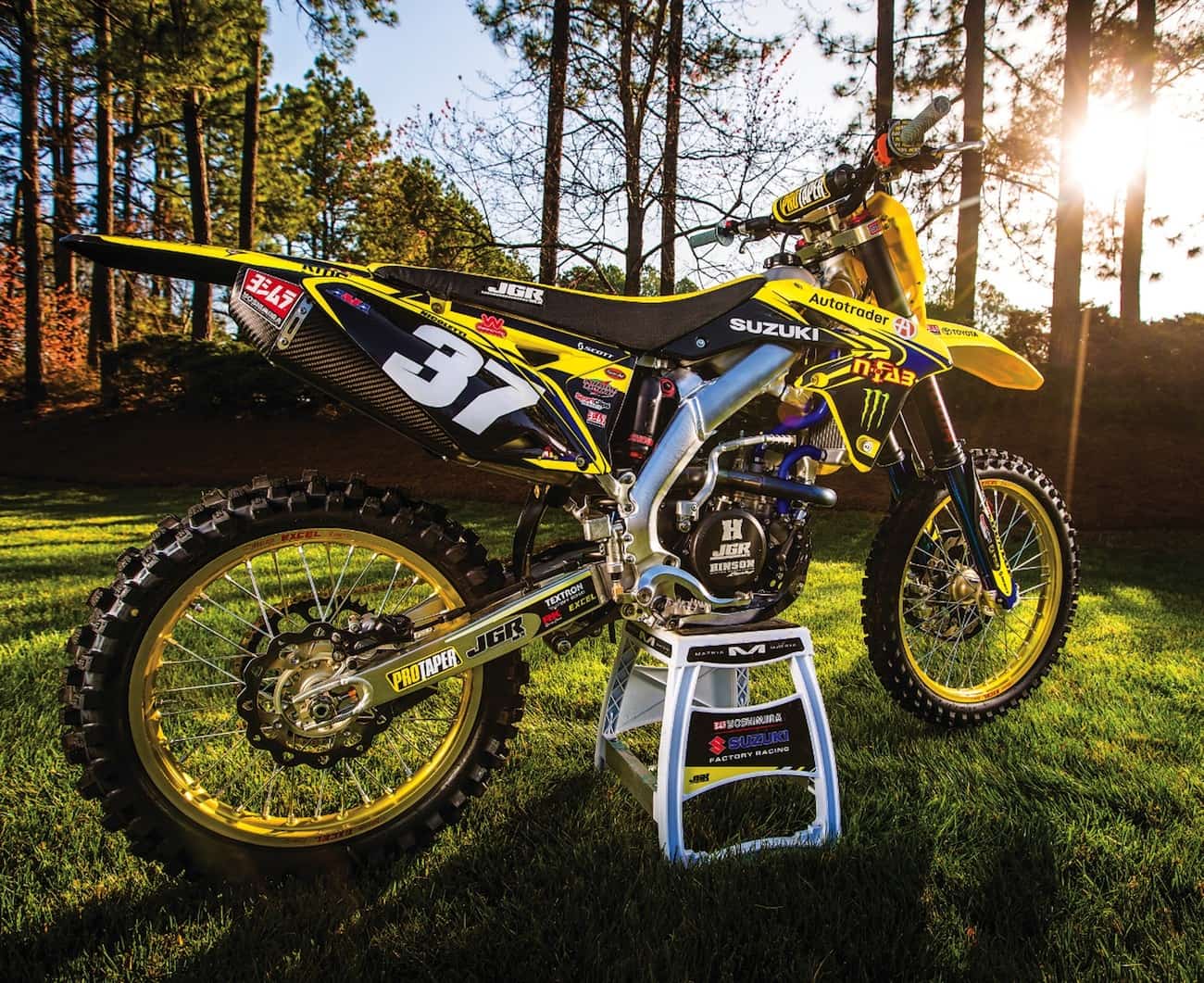




Comments are closed.